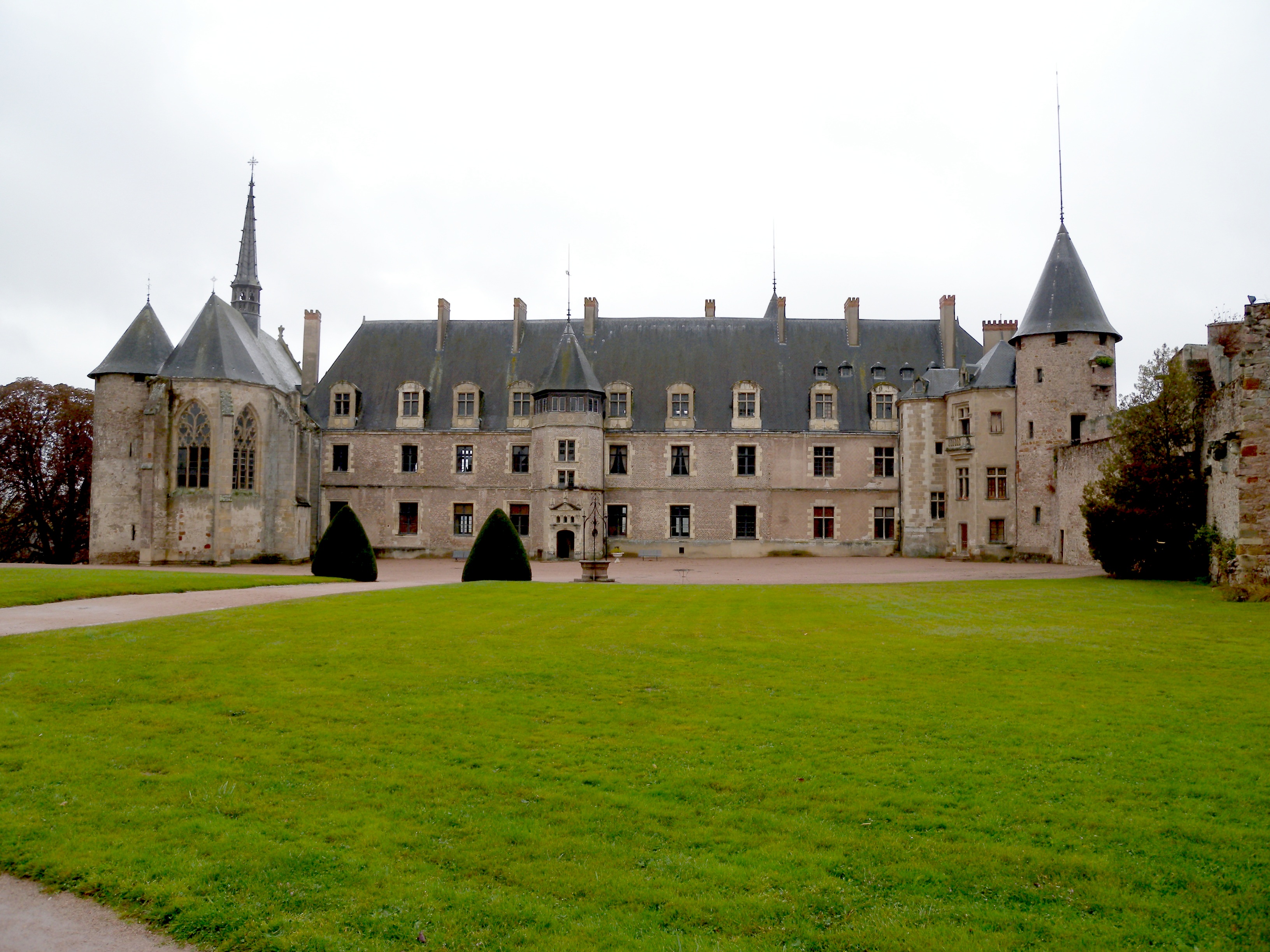|
Château De La Palice
The Château de La Palice is a castle, developed into a château, in the ''commune'' of Lapalisse in the Allier department of the Auvergne-Rhône-Alpes region of France. History Built between the 11th and 13th centuries, the feudal part of the castle was acquired by Jacques de Chabannes in 1430 or 1431. His grandson, Jacques II, '' maréchal'' of France, built the Renaissance wing at the beginning of the 16th century out of rose-coloured bricks, endowing the castle with sobriety and elegance. This wing replaced the wall connecting the fortress to the Gothic-style chapel, itself built c. 1470. The ceilings have raised colourful box beams inlaid with gold. Today, the fully furnished living rooms contain many historical artefacts as a museum of the castle's history. The Château de La Palice is listed as a ''monument historique'' by the French Ministry of Culture. See also * List of castles in France This is a list of castles in France, arranged by Region and Department. ... [...More Info...] [...Related Items...] OR: [Wikipedia] [Google] [Baidu] |
Château Lapalisse
A château (; plural: châteaux) is a manor house or residence of the lord of the manor, or a fine country house of nobility or gentry, with or without fortifications, originally, and still most frequently, in French-speaking regions. Nowadays a ''château'' may be any stately residence built in a French style; the term is additionally often used for a winegrower's estate, especially in the Bordeaux region of France. Definition The word château is a French word that has entered the English language, where its meaning is more specific than it is in French. The French word ''château'' denotes buildings as diverse as a medieval fortress, a Renaissance palace and a fine 19th-century country house. Care should therefore be taken when translating the French word ''château'' into English, noting the nature of the building in question. Most French châteaux are "palaces" or fine "country houses" rather than "castles", and for these, the word "château" is appropriate in English. ... [...More Info...] [...Related Items...] OR: [Wikipedia] [Google] [Baidu] |
Marshal
Marshal is a term used in several official titles in various branches of society. As marshals became trusted members of the courts of Medieval Europe, the title grew in reputation. During the last few centuries, it has been used for elevated offices, such as in military rank and civilian law enforcement. In most countries, the rank of Marshal is the highest Army rank (equivalent to a five-star General of the Army in the United States). Etymology "Marshal" is an ancient loanword from Norman French (cf. modern French ''maréchal''), which in turn is borrowed from Old Frankish *' (="stable boy, keeper, servant"), being still evident in Middle Dutch ''maerscalc'', ''marscal'', and in modern Dutch ''maarschalk'' (="military chief commander"; the meaning influenced by the French use). It is cognate with Old High German ' "id.", modern German ''(Feld-)Marschall'' (="military chief commander"; the meaning again influenced by the French use). It originally and literally meant ... [...More Info...] [...Related Items...] OR: [Wikipedia] [Google] [Baidu] |
Monuments Historiques Of Allier
A monument is a type of structure that was explicitly created to commemorate a person or event, or which has become relevant to a social group as a part of their remembrance of historic times or cultural heritage, due to its artistic, historical, political, technical or architectural importance. Some of the first monuments were dolmens or menhirs, megalithic constructions built for religious or funerary purposes. Examples of monuments include statues, (war) memorials, historical buildings, archaeological sites, and cultural assets. If there is a public interest in its preservation, a monument can for example be listed as a UNESCO World Heritage Site. Etymology It is believed that the origin of the word "monument" comes from the Greek ''mnemosynon'' and the Latin ''moneo'', ''monere'', which means 'to remind', 'to advise' or 'to warn', however, it is also believed that the word monument originates from an Albanian word 'mani men' which in Albanian language means 'rememb ... [...More Info...] [...Related Items...] OR: [Wikipedia] [Google] [Baidu] |
Castles In Auvergne-Rhône-Alpes
A castle is a type of fortified structure built during the Middle Ages predominantly by the nobility or royalty and by military orders. Scholars debate the scope of the word ''castle'', but usually consider it to be the private fortified residence of a lord or noble. This is distinct from a palace, which is not fortified; from a fortress, which was not always a residence for royalty or nobility; from a ''pleasance'' which was a walled-in residence for nobility, but not adequately fortified; and from a fortified settlement, which was a public defence – though there are many similarities among these types of construction. Use of the term has varied over time and has also been applied to structures such as hill forts and 19th-20th century homes built to resemble castles. Over the approximately 900 years when genuine castles were built, they took on a great many forms with many different features, although some, such as curtain walls, arrowslits, and portcullises, were ... [...More Info...] [...Related Items...] OR: [Wikipedia] [Google] [Baidu] |
List Of Castles In France
This is a list of castles in France, arranged by Region and Department. ;Notes: # The French word ''château'' has a wider meaning than the English ''castle'': it includes architectural entities that are properly called palaces, mansions or vineyards in English. This list focuses primarily on architectural entities that may be properly termed ''castle'' or ''fortress'' (french: château-fort), and excludes entities not built around a substantial older castle that is still evident. # Occasionally, where there is not a specific article on a castle, links are given to another article that includes details, typically an article on a town. # ''Italics'' indicate links to articles in the French Wikipedia. # If no article appears in either English or French Wikipedias, a link is given to an external website. # The number in parentheses after the name of each department indicates the department number used for administrative purposes. # The number of castles in France is estimated to abo ... [...More Info...] [...Related Items...] OR: [Wikipedia] [Google] [Baidu] |
French Ministry Of Culture
The Ministry of Culture (french: Ministère de la Culture) is the ministry of the Government of France in charge of national museums and the . Its goal is to maintain the French identity through the promotion and protection of the arts (visual, plastic, theatrical, musical, dance, architectural, literary, televisual and cinematographic) on national soil and abroad. Its budget is mainly dedicated to the management of the (six national sites and hundred decentralised storage facilities) and the regional (culture centres). Its main office is in the in the 1st arrondissement of Paris on the . It is headed by the Minister of Culture, a cabinet member. The current officeholder has been since 20 May 2022. History Deriving from the Italian and Burgundian courts of the Renaissance, the notion that the state had a key role to play in the sponsoring of artistic production and that the arts were linked to national prestige was found in France from at least the 16th century on. Durin ... [...More Info...] [...Related Items...] OR: [Wikipedia] [Google] [Baidu] |
Monument Historique
''Monument historique'' () is a designation given to some national heritage sites in France. It may also refer to the state procedure in France by which National Heritage protection is extended to a building, a specific part of a building, a collection of buildings, a garden, a bridge, or other structure, because of their importance to France's architectural and historical cultural heritage. Both public and privately owned structures may be listed in this way, as well as movable objects. As of 2012 there were 44,236 monuments listed. The term "classification" is reserved for designation performed by the French Ministry of Culture for a monument of national-level significance. Monuments of lesser significance may be "inscribed" by various regional entities. Buildings may be given the classification (or inscription) for either their exteriors or interiors. A monument's designation could be for a building's décor, its furniture, a single room, or even a staircase. An example is ... [...More Info...] [...Related Items...] OR: [Wikipedia] [Google] [Baidu] |
Renaissance
The Renaissance ( , ) , from , with the same meanings. is a period in European history marking the transition from the Middle Ages to modernity and covering the 15th and 16th centuries, characterized by an effort to revive and surpass ideas and achievements of classical antiquity. It occurred after the Crisis of the Late Middle Ages and was associated with great social change. In addition to the standard periodization, proponents of a "long Renaissance" may put its beginning in the 14th century and its end in the 17th century. The traditional view focuses more on the early modern aspects of the Renaissance and argues that it was a break from the past, but many historians today focus more on its medieval aspects and argue that it was an extension of the Middle Ages. However, the beginnings of the period – the early Renaissance of the 15th century and the Italian Proto-Renaissance from around 1250 or 1300 – overlap considerably with the Late Middle Ages, conventionally da ... [...More Info...] [...Related Items...] OR: [Wikipedia] [Google] [Baidu] |
Jacques De La Palice
Jacques de La Palice (or de La Palisse) (1470 – 24 February 1525) was a French nobleman and military officer. He was the lord of Chabannes, La Palice, Pacy, Chauverothe, Bort-le-Comte and Héron. In 1511, he received the title of Grand Master of France. As a Marshal under Francis I, he fought against Habsburg armies, and died during the battle of Pavia. Biography He was born at Lapalisse, Auvergne. At 15, La Palice entered the service of King Charles VIII of France, of his same age. His first battle was that of Saint-Aubin-du-Cormier (1488). Four years later he married Jeanne de Montbéron, daughter of chamberlain Eustache de Montbéron. In 1494 he followed the king in war for the Kingdom of Naples, taking part in the latter city's capture in 1495, as well as in the battle of Fornovo (1498) against the Italian League, which allowed the French army to retreat in their homeland. After Charles' death, La Palice accompanied the new King, Louis XII, in the campaign for M ... [...More Info...] [...Related Items...] OR: [Wikipedia] [Google] [Baidu] |
Castle
A castle is a type of fortified structure built during the Middle Ages predominantly by the nobility or royalty and by military orders. Scholars debate the scope of the word ''castle'', but usually consider it to be the private fortified residence of a lord or noble. This is distinct from a palace, which is not fortified; from a fortress, which was not always a residence for royalty or nobility; from a ''pleasance'' which was a walled-in residence for nobility, but not adequately fortified; and from a fortified settlement, which was a public defence – though there are many similarities among these types of construction. Use of the term has varied over time and has also been applied to structures such as hill forts and 19th-20th century homes built to resemble castles. Over the approximately 900 years when genuine castles were built, they took on a great many forms with many different features, although some, such as curtain walls, arrowslits, and portcullises, were ... [...More Info...] [...Related Items...] OR: [Wikipedia] [Google] [Baidu] |





.jpg)

